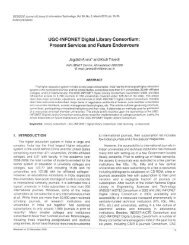PDF - CARL - ABRC
PDF - CARL - ABRC
PDF - CARL - ABRC
Create successful ePaper yourself
Turn your PDF publications into a flip-book with our unique Google optimized e-Paper software.
Collaborative Print Repositories: A Case<br />
Study of Library Directors' Views<br />
by Cathy Maskell, Jennifer Soutter and Kristina Oldenburg<br />
Available online 2 April 2010<br />
Surveys library directors in the Ontario<br />
Council of University Libraries consortium<br />
regarding weeding, last copy print<br />
archiving, and the role of the consortium.<br />
Responses reveal divergent opinions but an<br />
answer lies in partnerships. Cost remains an<br />
over-riding factor and the uncertainty of<br />
future budgets make commitment to<br />
long-term planning difficult.<br />
Cathy Maskell, Associate University Librarian,<br />
Leddy Library, University of Windsor<br />
;<br />
Jennifer Soutter, Digital Resources Librarian,<br />
Leddy Library, University of Windsor<br />
;<br />
Kristina Oldenburg, works as a<br />
reference librarian in Vancouver, BC<br />
.<br />
Document 9<br />
242 The Journal of Academic Librarianship, Volume 36, Number 3, pages 242–249<br />
INTRODUCTION<br />
The academic library is a different place, both physically and virtually,<br />
than it was 10 or even 5 years ago. Students and faculty demand access<br />
to digital collections at any time and from any place. Bricks-and-mortar<br />
libraries increasingly house technology labs, multimedia rooms, group<br />
study rooms, and cafés. Often, the library is one of the main computing<br />
centers on campus, facing ever-increasing calls for adequate electrical<br />
and network connections, more computer workstations, and a wide<br />
range of printing and scanning services. 1 Developing these user spaces<br />
usually means re-purposing existing physical facilities by shrinking<br />
collection footprints, since there is rarely money for new buildings.<br />
Thus many academic libraries are undertaking large-scale evaluations<br />
of their print collections to decrease the footprint of stacks and liberate<br />
space to expand technology and service areas. With the increasing<br />
duplication of print content in digital resources, the focus of this<br />
evaluation is often on journal collections.<br />
As the size and use of digital collections increases, the use of print<br />
resources decreases, particularly print journals. With pressures on<br />
space intensifying, these journal collections are being earmarked as<br />
candidates for storage, either within the institution or in some form of<br />
collaborative facility with other libraries. This leaves librarians<br />
grappling with what storage option best fits their needs and<br />
capabilities. Cooperative efforts to maintain at least one print copy<br />
of what is available digitally present an attractive option. 2 This<br />
collaboration usually involves libraries working together to house<br />
print serial volumes duplicated in digital, providing a backup in case<br />
access to the electronic version is lost, as well as archiving a print copy<br />
in case it is needed for future research.<br />
As academic libraries recognize the need to evaluate print<br />
collections and even weed those collections to liberate space, they<br />
also have a number of concerns about the effects of such initiatives on<br />
research, learning, and teaching support for their academic communities.<br />
Issues include the reliability of digital content, how well the<br />
digital replicates the print, and the possible long-term value the print<br />
artifact may have for research and scholarship.<br />
This article presents the results of a survey of library directors<br />
regarding their respective institutions' need for wide scale evaluation<br />
of print collections. It examines their need to weed or relocate<br />
items, their views on last copy print archiving, and their opinions<br />
on their consortium's role in any cooperative or shared last-print<br />
copy initiative. 3 The institutions are members of the Ontario Council<br />
of University Libraries (OCUL). Ontario university libraries face<br />
issues, noted in the literature review below, that confront academic<br />
libraries in locations around the world. The article begins with an<br />
overview of current issues relating to collaborative storage facilities<br />
for print collections. The literature review examines issues,<br />
practices, and context presented in scholarly articles, as well as in












